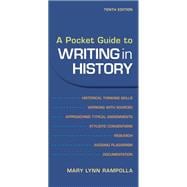
Note: Supplemental materials are not guaranteed with Rental or Used book purchases.
Purchase Benefits
Looking to rent a book? Rent A Pocket Guide to Writing in History [ISBN: 9781319244415] for the semester, quarter, and short term or search our site for other textbooks by Rampolla, Mary Lynn. Renting a textbook can save you up to 90% from the cost of buying.
1 Introduction: Why Study History
1a Asking historical questions
1b Developing historical reading skills
2 Working with Sources
2a Identifying historical sources
2a-1 Primary sources
2a-2 Secondary sources
2a-3 Primary or secondary? The changing status of a source
2a-4 Accessing sources in history
2a-5 Uses of primary and secondary sources
2b Evaluating sources
Tips for Writers: Questions for Evaluating Text-Based Primary Sources
2b-1 Evaluating primary sources
Tips for Writers: Questions for Evaluating Nonwritten Primary Sources
2b-2 Evaluating secondary sources
Tips for Writers: Questions for Evaluating Secondary Sources
2b-3 Evaluating online sources
2b-4 Identifying fake news
Tips for Writers: Questions for Evaluating Websites
3 Writing Short History Assignments
3a Reading actively in history
Tips for Writers: Writing as You Read
3b Writing about reading
3b-1 Summaries
3b-2 Annotated bibliographies
3c Writing about primary sources
3c-1 Single-source analysis
3c-2 Comparative papers
Tips for Writers: Writing a Comparative Essay
3d Writing about secondary sources
3d-1 Critiques and book reviews
3d-2 Comparing secondary sources
3e Writing about film
3f Taking history exams
3f-1 Preparing for an exam
3f-2 Answering identification questions
3f-3 Taking an essay exam
4 Following Conventions of Writing in History
4a Approaching a history assignment
4b Thinking like a historian
4c Developing a thesis
4d Constructing an argument
Tips for Writers: Testing your Thesis
4d-1 Supporting your thesis
4d-2 Responding to counterevidence and anticipating opposing viewpoints
4e Drafting your paper
4e-1 Drafting an introduction
4e-2 Organizing your paper
4e-3 Writing clear and connected paragraphs
4e-4 Writing an effective conclusion
4f Revising for content and organization
Tips for Writers: Revising for Content and Organization
4g Editing for style and grammar
Tips for Writers: Common Grammatical Errors (and How to Avoid Them)
4g-1 Choosing appropriate language
4g-2 Choosing the appropriate tense
4g-3 Using active voice
4g-4 Knowing when to use the pronouns I, me, and you
5 Writing a Research Paper
5a Moving from topic to research question
5a-1 Choosing a topic
5a-2 Focusing on a research question
5b Developing a research plan
5c Conducting research
5c-1 Consulting human resources
5c-2 Using a library’s online catalog
5c-3 Using print and electronic reference sources
5c-4 Locating primary sources
5c-5 Locating secondary sources
5c-6 Finding internet sources
Tips for Writers: Electronic Databases
5c-7 Distinguishing among electronic sources
5d Taking effective research notes
5e Developing a working thesis
5f Making an outline
5g Revising and editing your paper
6 Plagiarism: What It Is and How to Avoid It
6a What is plagiarism?
6b Avoiding plagiarism
6b-1 Citing sources to avoid plagiarism
6b-2 Paraphrasing to avoid plagiarism
Tips for Writers: Avoiding Plagiarism
6b-3 Downloading internet sources carefully to avoid plagiarism
6c Plagiarism and the internet
7 Quoting and Documenting Sources
7a Using quotations
7a-1 When to quote
7a-2 How to quote
7b Documenting sources
7b-1 Footnotes and endnotes
7b-2 Bibliography
7b-3 Documenting nonwritten materials
7c Documentation models
7c-1 Formatting guidelines for footnotes and endnotes
7c-2 Formatting guidelines for bibliographies
7c-3 Models for notes and bibliography entries
7d Sample pages from a student research paper
The New copy of this book will include any supplemental materials advertised. Please check the title of the book to determine if it should include any access cards, study guides, lab manuals, CDs, etc.
The Used, Rental and eBook copies of this book are not guaranteed to include any supplemental materials. Typically, only the book itself is included. This is true even if the title states it includes any access cards, study guides, lab manuals, CDs, etc.